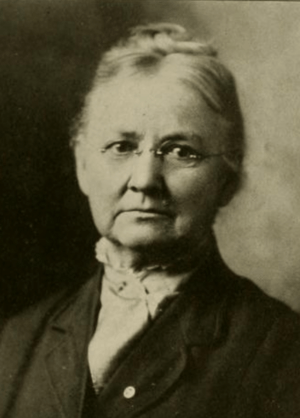Ellen Hayes facts for kids
Quick facts for kids
Ellen Hayes
|
|
|---|---|

Ellen Amanda Hayes, from a 1915 publication
|
|
| Born | September 23, 1851 |
| Died | October 27, 1930 (aged 79) |
| Nationality | American |
| Alma mater | Oberlin College |
| Scientific career | |
| Fields | Mathematics Astronomy |
| Institutions | Adrian College Wellesley College University of Virginia |
Ellen Amanda Hayes (born September 23, 1851 – died October 27, 1930) was an American mathematician and astronomer. She was known for her strong beliefs and for supporting many new ideas. This made her a unique and important person in her time.
Contents
Early Life and Education
Ellen Hayes was born in Granville, Ohio. She was the first of six children. When she was seven, she went to a small, one-room school. At sixteen, she started working as a teacher in a country school.
In 1872, she began studying at Oberlin College. She focused on mathematics and science. She became a freshman student in 1875.
Teaching and Astronomy Work
Ellen Hayes earned her degree from Oberlin College in 1878. After that, she started teaching at Adrian College. She was also very interested in astronomy. She even helped figure out the path of a newly found asteroid called 267 Tirza. She did this while studying at the University of Virginia's Leander McCormick Observatory.
From 1879 until she retired in 1916, she taught at Wellesley College. She became the head of the mathematics department in 1888. Later, in 1897, she led the new department of applied mathematics. Some people said she was removed from leading the math department. This was because of disagreements about how students should be admitted.
Ellen Hayes was known for wearing practical clothes. This was different from the fancy clothes many women wore then. She was described as "strong-willed." At that time, a man with similar traits might have been called "highly principled."
Teaching Style and Beliefs
As a math professor, Ellen Hayes had very high standards. She once gave low grades to more than half of her students. This happened during her first year teaching from her trigonometry book. Even with her tough teaching style, many students admired her. They followed her ideas and learned a lot.
She also shared her thoughts on important topics. In 1888, she wrote a column for the Wellesley College newspaper. She discussed women's right to vote and ideas about clothing reform. In the 1890s, she started a group that supported the temperance movement. This movement encouraged people to drink less alcohol.
In 1891, Ellen Hayes was one of the first six women to join the New York Mathematical Society. This group later became the American Mathematical Society. She was also recognized as a Fellow of the American Association for the Advancement of Science in 1905.
A history book about Wellesley College described her this way:
She was a brave person who always supported new ideas. In the 1880s, she wore short skirts. In the 1890s, she strongly supported women's right to vote. In the early 1900s, she was a strong believer in socialism. After she retired, she worked with a school for young working women until she died in 1930. She was fearless and dedicated. Even though she sometimes caused trouble for the college leaders, many of her students remember her with great warmth and respect.
—History of Wellesley College
Supporting Women in Science
Ellen Hayes was worried that not enough women were studying math and science. She believed this was because of several reasons:
- Social pressure on women.
- Too much focus on how women looked.
- Few job opportunities for women in math and science.
- Schools allowing girls to skip math and science classes.
Social Activism
Ellen Hayes was a unique figure. She was one of the few women who were math professors in the 1800s. She also supported many new and sometimes challenging ideas. These included:
- Having different ideas about some traditional beliefs.
- Challenging clothing rules for women.
- Supporting women's right to vote (suffrage).
- Promoting the temperance movement.
- Believing in socialism, which is about sharing resources more equally.
- Supporting workers during the 1912 Lawrence textile strike.
- Protesting the execution of Nicola Sacco and Bartolomeo Vanzetti.
In 1912, she ran for Massachusetts Secretary of State. She was a candidate for the Socialist Party USA. This made her the first woman in Massachusetts to run for a statewide office. She did not win, but she received more votes than any other Socialist candidate on the ballot that year.
During the Russian Revolution, many people in America were afraid of communism. Despite this, Ellen Hayes raised money for Russian orphans. She also defended her belief in socialism. When she was 76 years old, she was arrested. This happened when she marched to protest the execution of Sacco and Vanzetti.
Later Life and Legacy
Ellen Hayes wrote two books. Wild Turkeys and Tallow Candles (1920) was about life in Granville. The Sycamore Trail (1929) was a historical novel.
In 1929, she moved to West Park, New York. She taught at the Vineyard Shore School for women who worked in factories. She did this even though she had pain from arthritis. She passed away on October 27, 1930. In her will, she left her brain to the Wilder Brain Collection at Cornell University. Her ashes were buried in Granville, Ohio.
See also
 In Spanish: Ellen Hayes para niños
In Spanish: Ellen Hayes para niños

